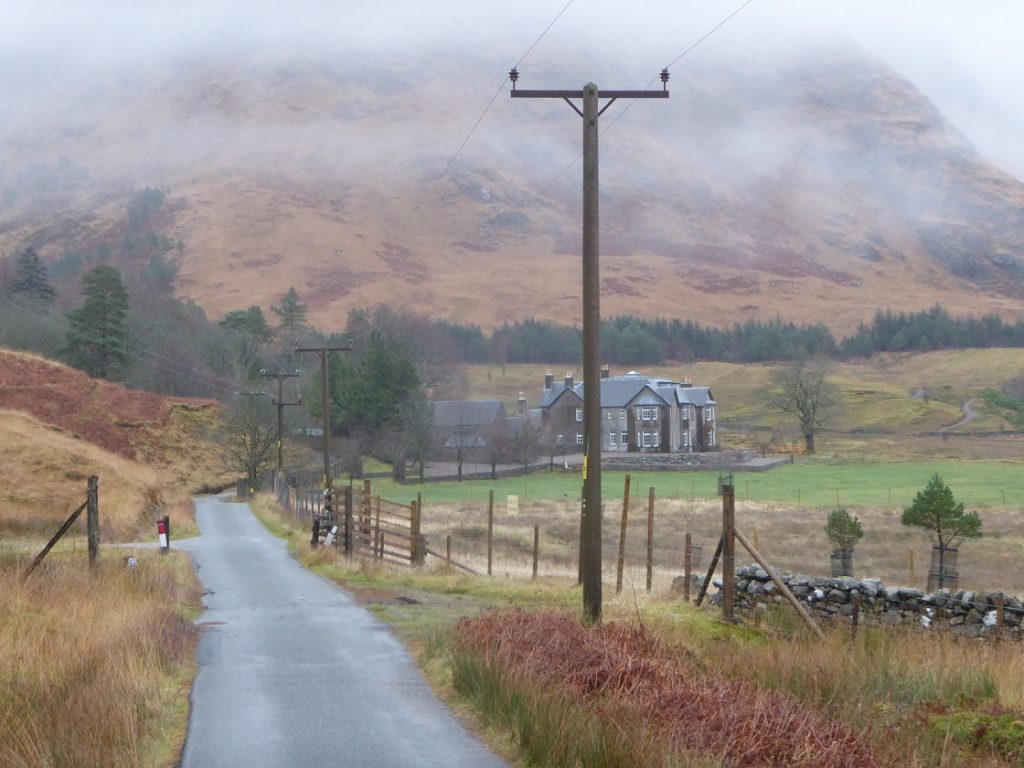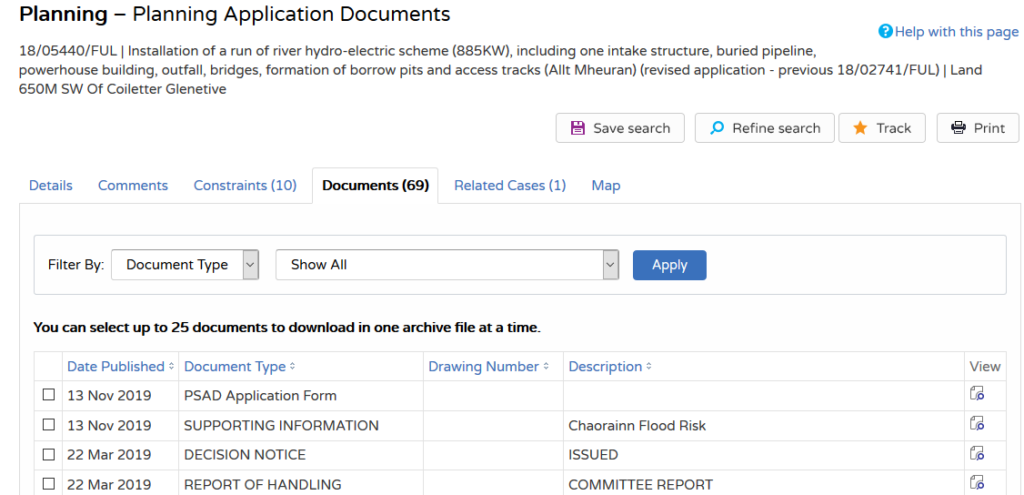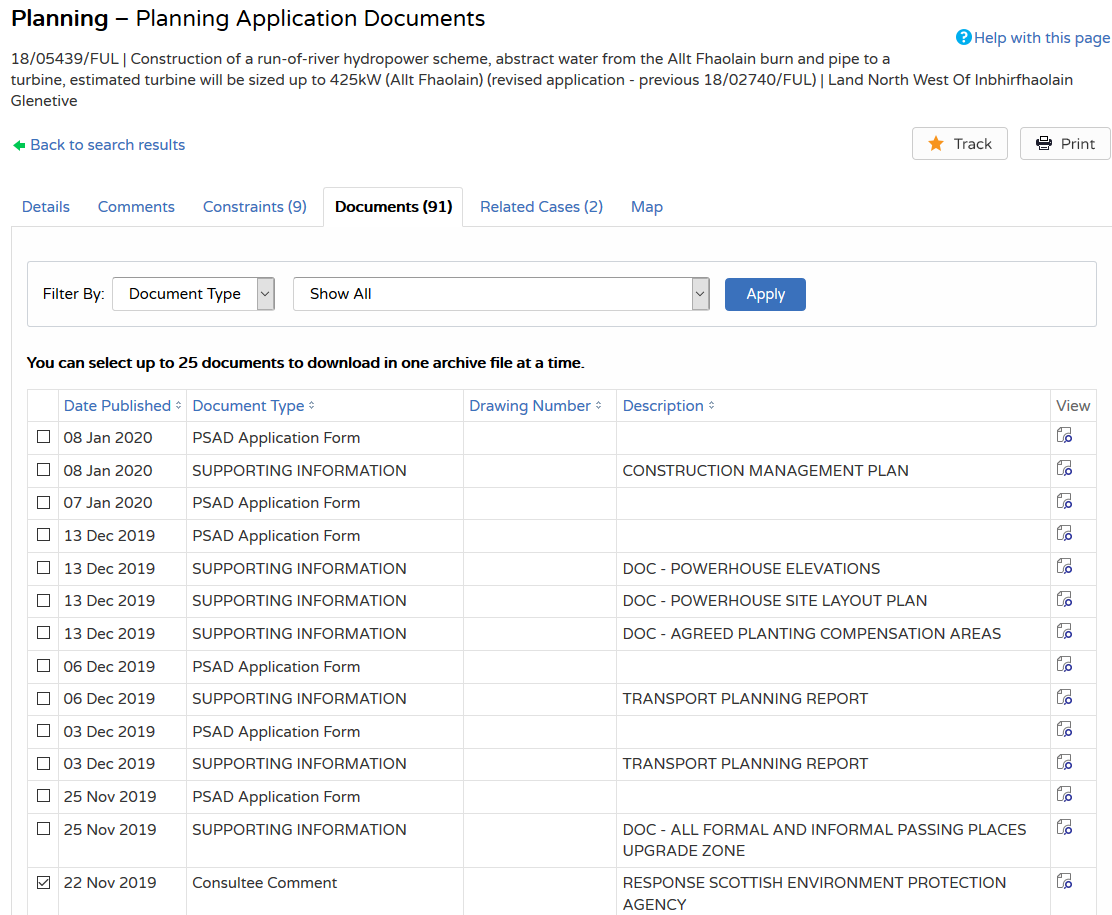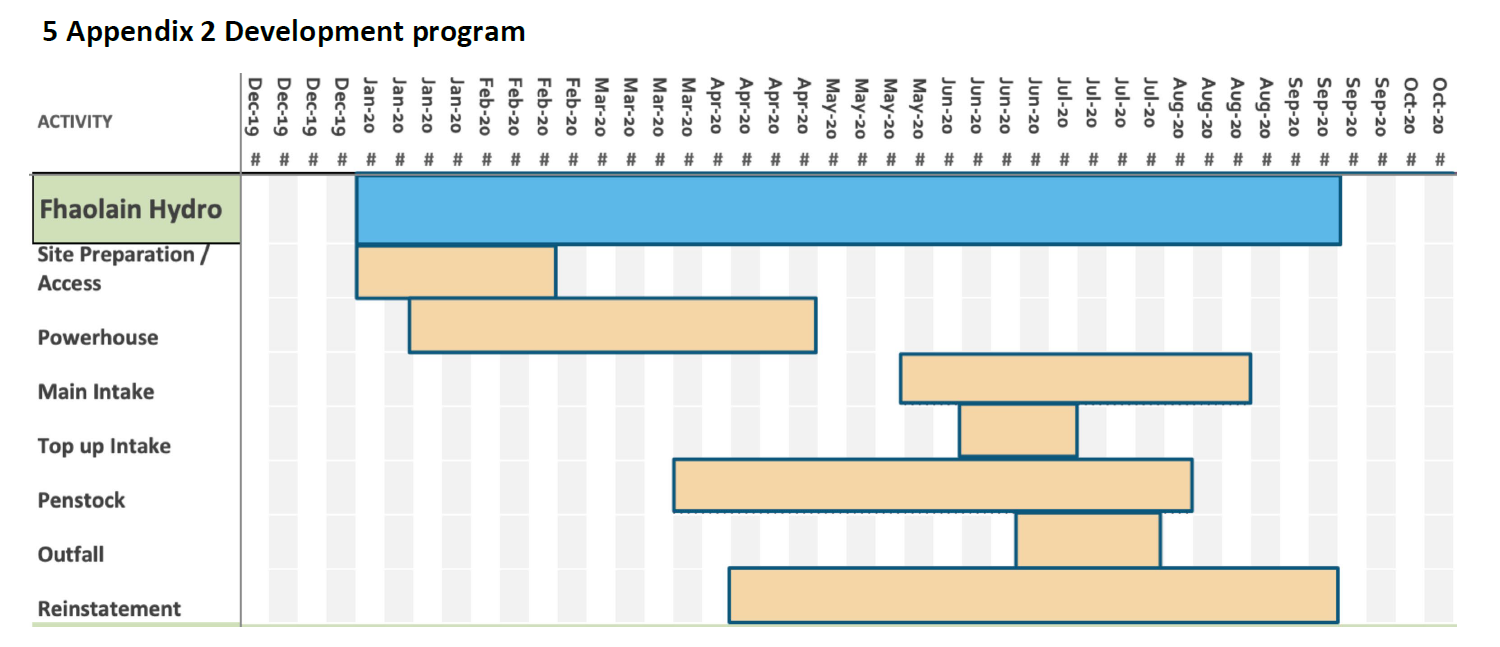
Preparatory work for the seven hydro schemes which Highland Council approved with conditions last March has now started. There are two separate pieces of work, one to upgrade the powerline in the glen, the other to upgrade the road so that construction traffic can use it without blocking visitors from the glen. Meantime the revised planning documentation from the developer, William Dickins, which has been published by Highland Council since my Etive Update in September, raises more questions than its answers. This post takes a look at some of the issues.
The powerline upgrade
At the end of November Highland Council officers approved a planning application to upgrade the powerline which runs for 16.7km down Glen Etive from 11kv to 33kv in preparation for the new hydro schemes (see here for papers). The first part consisted of a new 2.75 km section of undergrounded line from the Kingshouse to replace the overhead line from the Glen Coe ski centre to the Glen Etive road. The second part involved replacement of the rest of the overhead line – almost 10 miles of it – to the bottom of the Glen.
There was not a single comment from any member of the public or environmental organisation on the application, despite all the concerns expressed about the Glen Etive hydro scheme. Mea culpa but nothing either from Save Glen Etive, with whom I am involved, the National Trust for Scotland (whose Glen Coe property overlooks the glen), Mountaineering Scotland, Grampian Club etc. The reason is not I believe that people didn’t care, rather its that they didn’t know. All Highland Council needed to do was to alert those who had commented on the Etive hydros, with which this application was inextricably linked, and they could have publicised the application and received useful comments to boot. That is not, however, how are planning system works, its designed for developers not people.
It did not take long for SSE to commence the work as diggers were clearly in evidence near the A82 at the end of December. As far as I could see, travelling north and south at New Year in the rain, they were doing a reasonable job. That raises the question, however, why didn’t SSE take the opportunity to underground the entire line? And why too didn’t Highland Council ask for this when in their assessment of the application they stated:
“The undergrounding and dismantling work proposed will result in betterment in terms of landscape and visual impact for this part of Rannoch Moor.”
Set aside the inconsistency of Highland Council in also approving on this part of Rannoch Moor the track that now forms a terrible new scar above the Glen Coe mountain car park (see here), why doesn’t the rest of Glen Etive, which is a National Scenic Area, deserve “betterment”? Without public pressure and with Scottish Natural Heritage, the agency responsible for looking after our NSAs, having no concerns about the development’s landscape impact, its hardly surprising that Highland Council Planners simply rubber stamped SSE’s plans.
At a Scotland-wide level we are in the ridiculous situation where SSE is being paid (by the public) to underground powerlines in some areas because of their visual impact (see here) but is being allowed to upgrade other powerlines without any consideration of the potential to reduce their landscape impact. It would cheaper and more effective, particularly if moles were used (see here), if the default position was that all powerlines in protected areas were under-grounded as a matter of course when they are being upgraded. The Scottish Government is in a deep slumber, nae appears sedated, when it comes to landscape matters.
The road upgrade

Highland Council roads staff and Planning Committee were very concerned to minimise the impact of hydro construction traffic on the existing road, residents and visitors and, as a consequence, much construction material was to be brought in by boat and then taken part way up the glen by forest tracks. There would, however, be no avoiding the road to the Allt Fhaolain and Allt Chaorain from beyond the Allt Charnan scheme, hence the layby upgrade proposals (see above). These have been submitted along with a new Transport Plan, which proposes using larger 20 tonne vehicles to reduce the number of trips and a consequent strengthening of two bridges.
Among the Planning Conditions Highland Council attached to the planing consent were “a scheme of passing place improvements to the C1094 public road from the access to the forestry track at Invercharnan” (Condition 5) and that “No development shall commence until the Construction Traffic Management Plan has been updated to reflect the commitments made in the Transport Planning Report (23.11.18), the restriction on vehicles over 18 tonne gross weight” (Condition 4). There is a clear contradiction between the 18 tonne weight limit set by Highland Council and Dickins proposals for 20 tonne lorries and bridge strengthening. There is nothing on the Planning Portal to indicate whether Highland Council have agreed to amend Planning Condition 4 or, if not, why they have allowed Dickins to commence work when the Transport Plan breaches the original planning conditions.
Deficiencies in the planning documentation for the seven hydro schemes
To their credit, like the Cairngorms National Park Authority but unlike the Loch Lomond and Trossachs National Park Authority (see here), Highland Council have agreed to make public all planning documents for the Glen Etive hydro schemes along with all monitoring reports, if and when construction starts. That level of transparency is to be commended. However, the documentation that Dickins Hydro Resources, which basically appears to be a one person operation, has submitted to date is chaotic, far from complete and raises concerns about the competence of the developer.
Highland Council issued separate planning consents for all seven schemes, with some conditions common to all schemes but some no. For example the Allt Gaoirean scheme has 19 conditions attached to it compared to 22 for the Allt Fhaolain. In order to meet these conditions a number of detailed designed documents require to be submitted and approved before work commences. So far, the main schemes for which additional documentation has been submitted since planning approval in March last year are the Allt Gaoirean and Allt Fhaolain schemes cited above.
For the other five schemes there is very limited information:

Strangely, the information for the Allt Mheuran, doesn’t show the passing places document and a new application document and a flood risk document for the Allt Chaorain – a completely different scheme!

The lack of documentation for the three very sensitive schemes on the east side of Glen Etive, in the Wild Land Area, the Allt Chaorainn, the Allt Ceitlein and the Allt Mheuran, is of particular concern.
A handful of the documents while have been lodged for ONE scheme are clearly intended to cover all seven (the proposed tree planting areas, the transport plan, the locations for layby improvements). While their failure to appear under all seven may be due to hardpressed Planning Staff not having time to upload documentation – and the Passing Places document dated 25th November which was published on the portal for the Allt Charnan was NOT there when I looked a week ago – other problems and gaps appear to be the responsibility of the developer.
Of the documents that have been lodged by Dickins, there is lots of duplication e.g. for the Allt Fhaolain, by the Grampian Club Hut at Inbhirfhaolain, I counted 10 different PSAD application forms – heaven knows why they keep lodging them – and there are two transport plans:

This makes it particularly hard to understand what is going on.
There are also huge problems understanding what is being proposed. To take one example, among the Planning conditions, there are requirements for all schemes to have a Construction Management Plan and a Construction Method Statement. The Allt Fhaolain has a Construction Management Plan (two actually, uploaded just a few days apart!) while the Allt Gaoirean has both a Construction Management Plan and Construction Method Statement uploaded on 9th December. However, how these relate to a single document for the Allt Gaoirean which contained both a CMS and CMP and was lodged in September is not clear.
Moreover, in the revised documentation there are significantly gaps, with absolutely nothing for example on how access tracks will be constructed and restored. While there is on the Allt Gaoirean portal an earlier document described as Construction Standards (see here), which does contain some information on track construction and is described as Supplementary to the Construction Method Statements, its not referred to in the new CMS which has been produced by the Contract AB Gairns and not the developer, Dickins. Its impossible therefore to tell how documents relate to each other, which have been superceded and what is actually being proposed.
Clarity on this is essential if the disaster which is in the making in Glen Etive is not to become catastrophic.
As far as I can tell from the documentation Dickins has also so far not responded to the main requests SEPA made on 22nd November for further information to fulfil planning conditions (see here). These included how Dickins proposes to cut down through the rock to get to the intake areas, provision of maps setting out the full footprint of the works, drawings of pollution control measures. I can, however, find references to 20m construction corridors which SEPA have rightly said are far too wide.
There are other basic gaps. For example the Construction Management Plan names the Ecological and Landscape Clerk of Works but does not say HOW they will meet Highland Council Planning Condition 3b:
Details of the roles and responsibilities of the appointed Environmental Clerk of Works (ECoW), Landscape Clerk of Works (LCoW), and Arboriculturalist including frequency of monitoring and any specific accountability
This should be simple. Normally two weekly written reports with photos and lists of actions taken as a result of any advice from these Clerk of Works should as a minimum be submitted to the Planning Authority. Simple omissions such as this don’t inspire confidence in the developer’s ability to build the hydro schemes without trashing Glen Etive
All this is even more alarming when, according to the Dickins timelines set out in the Construction Management Plans, they should have started work on their access tracks by now:

What needs to happen
I feel sorry for the Council Staff who are having to try and sort out what appears to me, having spent a few hours trying to get to grips with Dickins documentation, an almighty mess. Whatever the challenges, however, staff should not be tempted to take short-cuts. Having approved the hydro applications, in Glen Etive more than anywhere, there is a need to ensure the dveloper and their contractors conduct any work according to the highest standards. Until Highland Council staff are certain, therefore, that Dickins’ plans are fit for purpose and the documentation on the planning portal reflects this, the Etive hydro schemes should not be given the go-ahead.

Hello all at Parkswatch Scotland,
Many thanks for the update. Like you I was an initial firm objector, but was kept in the dark about further changes/developments, and therefore unable to make further objections.
Having seen at first hand the Hydro devastation at the remote ‘Teahouse’ in Torridon, and towards the Heights of Kinlochewe it really is essential to press Highland Council really, really hard to insist on their strict conditions being met.
Perhaps forward this informative update for a start.
Good luck with you efforts, much appreciated by us all.
George
Please stop being so puritanical in your outlook, and don’t let the the “perfect be the enemy of doing the right thing”. We are faced with a truly daunting climate emergency and clinging on to high traditional ideals in context is really really not helping emissions reduction progress. I drove down the glen today and think the development is entirely appropriate for the situation we all find ourselves in.
So responding to the climate emergency means… destroying the environment?
I take it you were driving a clockwork car to help save us all from this truly daunting climate catastrophe
Was down Glen Etive yesterday towards Ben Starav. I doubt Highland Council have seen whats happened recently but what an absolute mess. Roads are far too wide, 1m pipe is being laid on surface and covered – not sunk, runoff control is poor. The ground will not recover in 100years. The whole glen is ruined from midway down to the loch. I’d rather have 1 big bad hydro dam somewhere else than 100 of these stupid ecodisaster microhydro schemes.
Been down Glen Etive recently, things look better.
Pipes did get buried and ground reinstatement has happened. The crap has been cleared away at least. Things are greening up.
Quite a scar still at Allt Mheuran.
Forestry work really blighting the land on the west side; worse impact than the hydro.
Glad to hear it, thank you for the update. Highland Council are not known for checking that planning conditions are met and I had to send them photos of the litter of pipes and cable drums etc that had been left behind. Glen Affric is finally healing after the damage they did there with micro hydro, but now they’re about to restore some peatland. It never stops.